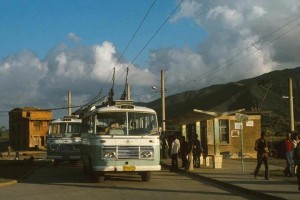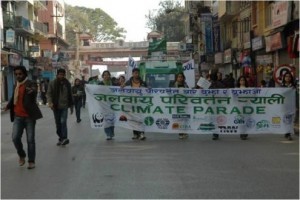This article was published on MYREPUBLICA (31 July, 2012)
In a bid to promote clean technology in the country, Nepal has more than 700 electric vehicles (Safa tempos) running in the valley—a commendable effort to reduce its dependency on fossil fuels. Safa tempos are best driven for short distances and at relatively slow speeds, all of which suits the natural topography of Kathmandu valley. These green machines, which are mostly operated by women drivers, hold a lot of potential for the country’s economy and can tap Nepal’s massive hydropower potential to create a regional energy grid that contributes significantly in reducing GHG emission in the region.
The Trolley Bus Service The interurban line (Trolley Bus Service) that connects Kathmandu to the satellite towns ceased its operation around November 2008. Established in 1975 and managed by the Nepal Trolley Bus Service (NTBS) of Nepal Transportation Corporation (NTC), the system functioned well in its early stages. At that time, this was one of the cheapest and most desirable modes of transport in the valley. With the change in political set up in the country in the 1990s, the management of the trolley bus service encountered hostile government bureaucracy and the organization’s overstaffing resulted in huge losses for NTBS. The revenue collected from fares was not enough to pay even the electricity bills or staff salaries. Currently, its office compound at Baneshwar is occupied by another implausible project, the Melamchi Water Supply. A part of its space is managed as battery charging station for Safa tempos, where they get uninterrupted electric supply even during load shedding.
The interurban line (Trolley Bus Service) that connects Kathmandu to the satellite towns ceased its operation around November 2008. Established in 1975 and managed by the Nepal Trolley Bus Service (NTBS) of Nepal Transportation Corporation (NTC), the system functioned well in its early stages. At that time, this was one of the cheapest and most desirable modes of transport in the valley. With the change in political set up in the country in the 1990s, the management of the trolley bus service encountered hostile government bureaucracy and the organization’s overstaffing resulted in huge losses for NTBS. The revenue collected from fares was not enough to pay even the electricity bills or staff salaries. Currently, its office compound at Baneshwar is occupied by another implausible project, the Melamchi Water Supply. A part of its space is managed as battery charging station for Safa tempos, where they get uninterrupted electric supply even during load shedding.
THE BIRTH OF ELECTRIC VEHICLES The advent of Safa Tempo’s in Kathmandu has replaced the notoriously environment unfriendly Vikram tempos that run on diesel. The development and promotion of Safa tempos in Nepal was initially supported through international projects. This later developed into a bigger EV industry with over 700 Safa tempos operating in more than 13 routes in Kathmandu. The journey was not as simple for other electric vehicles. When the first REVA car arrived in February 2001, it was bunged at the customs office for several months due to customs duty and additional special taxes. There are other similar stories for four and two wheeler electric vehicles that faced enormous challenges at all stages of import, registration and deployment to road and users.
The advent of Safa Tempo’s in Kathmandu has replaced the notoriously environment unfriendly Vikram tempos that run on diesel. The development and promotion of Safa tempos in Nepal was initially supported through international projects. This later developed into a bigger EV industry with over 700 Safa tempos operating in more than 13 routes in Kathmandu. The journey was not as simple for other electric vehicles. When the first REVA car arrived in February 2001, it was bunged at the customs office for several months due to customs duty and additional special taxes. There are other similar stories for four and two wheeler electric vehicles that faced enormous challenges at all stages of import, registration and deployment to road and users.
Today, there are more than 700 three wheeler, approximately 1500 two wheeler and few four wheeler electric vehicles on our roads.
The prevailing law does not recognize a two wheeler as a ‘vehicle’ and that is why we do not have the exact figure of how many such vehicles are running in the country.
Electric vehicles play a vital role in boosting the national economy of a country by making use of locally produced hydropower and minimizing air pollution as well as mitigating greenhouse gas emissions. It also contributes to an environmentally sustainable transport system and creates economic benefits for the country. More than 95 percent of our electricity comes from hydropower, which is undoubtedly a clean source of energy. Nepal has a soaring potential of hydro-electricity generation capacity that has remained untapped for many years.
LEVEL-PLAYING GROUND
Various studies have confirmed that transportation is one of the major emitters of carbon dioxide, causing global warming. Likewise, it is very evident how polluted the air in Kathmandu is, for which our means of transport are mainly to blame. Considering these facts, stakeholders have come together to establish a permanent system to promote clean technology within a national framework. A team of bureaucrats from different line of ministries led by the director general of the Transportation Management Department, along with experts and stakeholders, is engaged in drafting a policy for the promotion of electric vehicles in the country.
Changes in policies can make the EVs economically beneficial as well as competitive. Undoubtedly, the policy should focus on the promotion of manufacturing, conversion, import and use of these zero emission electric vehicles for public transportation as well as for movement of goods and also private use. Likewise, there are other issues such as effective battery management and its disposal and the management of charging stations for electric vehicles. With the advancement of technology within the country, there is a need for a new research and development entity, which can be facilitated by the establishment of a dedicated apex body within the government system in collaboration with research institutions or universities.
RENEWABLE ENERGY POTENTIAL
Despite Nepal’s huge potential in harnessing various renewable energy sources such as hydropower, solar power, wind energy and biofuels/bioenergy, it has been unable to sustainably capture them due to geographical, technical, political and economical reasons. Nepal will undoubtedly benefit from a long-term vision of realizing and utilizing its own hydroelectric power and reducing the import of expensive, polluting petroleum-based fossil fuels. EVs utilize hydropower electrical energy for charging batteries. Most of the country’s hydropower plants are powered by rivers with a huge portion of electricity just gets wasted during non-peak hours at night. This unused electricity could be used to charge batteries and operate battery-powered electric vehicles during the day and contribute to the improved living conditions of people in Nepal.



